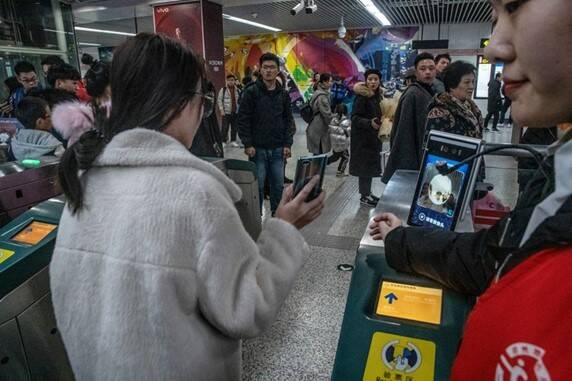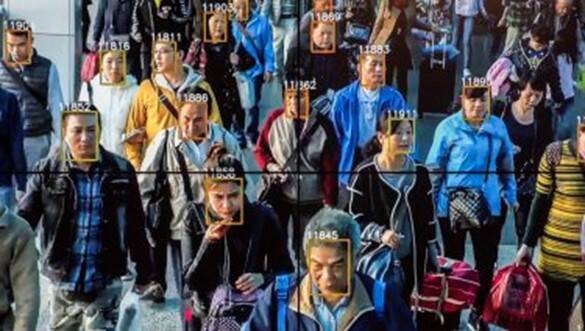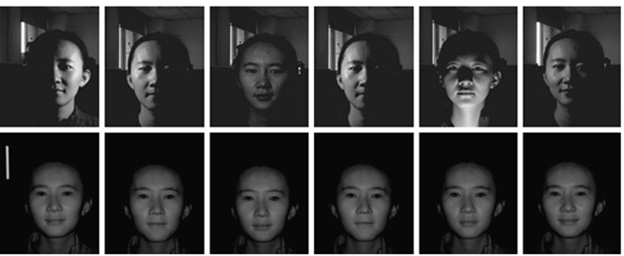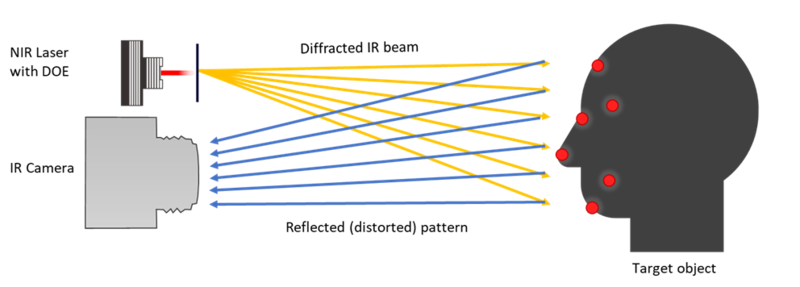Facing the Future: Growth in NIR Facial Recognition
As a human, your face is your identity, completely unique among billions. Even newborn infants can track and recognize faces. Recently, computer systems have been coming close to matching the performance of human vision for facial recognition (FR) as the number of technologies, systems, and applications grows. Rapid adoption of FR technology is expected to continue, with the global market forecast to grow 17.7% CAGR through 2025, reaching revenues of $8.5 billion.1
There are two main types of facial recognition systems: 2D systems that rely on analysis of two-dimensional photographic or video images of a person’s face, and 3D systems that use near-infrared (NIR) light patterns to detect facial geometry. Recently, some thermal imaging FR technologies have also emerged. Most of the facial recognition (FR) that we hear about in the news is the 2D type. For example, law enforcement can use FR software to analyze photographs of an event and identify people who instigated violence.2 Photographic FR is also used to check faces at airport security and help find missing persons.

A facial-recognition scanning system at the entrance to a subway station in Zhengzhou, China, December 2019. (Image Credit: Gilles Sabrié/NYT/Redux/eyevine)
Concerns About 2D Facial Recognition
In a several recent cases in the U.S., 2D facial recognition algorithms have mis-identified innocent people as wanted criminals, most frequently African Americans. Studies show that photo-based 2D FR is less accurate for people with darker skin.3 Under ideal conditions, 2D FR has been shown to have near-perfect accuracy—as much as 99.97%4 scored on NIST’s Facial Recognition Vendor Test (FRVT). But “ideal” conditions of a well-lit, face-forward photographic image without any obstructions cannot always be met in dynamic situations like a crowded public space where there are multiple people moving around.
Due to concerns about bias and privacy, 2D FR systems are under scrutiny to determine how and when they should be used. Nevertheless, multiple law enforcement success stories5 continue to show the value of facial recognition, and testing continues to improve accuracy of analysis algorithms.

A CCTV display using the facial-recognition system Face in Beijing, which helped police successfully identify and arrest a wanted criminal trying to blend into 60,000 patrons at stadium concert. (Image credit: The Washington Post/Gilles Sabrié)
Identification vs. Authentication
These 2D FR applications are generally grouped under the category of “identification.”. Using FR to verify a person’s identity for access to a device or facility is more commonly referred to as “authentication.” While 2D systems have been used for authentication purposes, most of these applications now rely on 3D technology. For example, NIR facial scanning is well known for its use in biometric authentication on smart phones and other personal devices.
These 3D systems work by casting a pattern of invisible NIR light—from an LED or laser emitter—on a person’s face to measure not only two-dimensional elements such as the distance between our eyes, but also depth, such as the length of our nose. By creating a 3D “map” of the face, NIR systems can be much more accurate.
Other advantages of 3D FR technology include:
- Ability to measure faces in low light or darkness
- Ability to correctly identify faces when viewed from different angles
- Security from “spoofing”—using the photo of a person’s face to try and fool an FR system.

Comparison of images taken by a 2D color camera in various ambient light conditions (top row) with images taken by an NIR imaging system that show complete and consistent capture of the entire face. (Image Source)
With their superior accuracy, 3D facial recognition systems are now being looked at as a method to improve identification applications that currently use 2D, such as airport security.6 But limitations on 3D sensing range are now pointing some researchers towards a fusion of 2D and 3D techniques (multi-modal) to achieve optimal accuracy in these settings.7
Quality Considerations for NIR Light Sources
Even with the advantages of NIR FR, these systems can still be prone to performance issues like emission points in the wrong position, low-output emissions, or inconsistent NIR light source intensity. There are also safety concerns: NIR wavelengths are invisible to humans, so we don’t blink or look away if our eyes receive NIR light at unsafe intensities or long exposures, which could cause damage to the cornea and retina.
NIR authentication systems require careful design and testing to ensure light is emitted at appropriate intensities and in the expected patterns. 3D facial recognition technology relies in part on “reading” complex patterns of emission points (dots, lines, or other shapes) that are cast by an NIR emitter through a filter, called a Diffractive Optical Element (DOE). An NIR camera then captures the pattern as it is reflected back by the person’s face, identifying changes in the pattern to map facial contours.

NIR facial recognition systems cast NIR light through a DOE filter towards the face (yellow beams) in a defined pattern, and capture the reflection of that pattern with an NIR camera (blue beams), to measure distortion caused by facial contours.
To ensure accuracy, manufacturers of FR systems and components need to measure NIR sources for emission uniformity and distribution, spatial positions of pattern elements, radiant flux, and maximum intensity or power—across the entire distribution area. For NIR facial-recognition systems—and other NIR 3D sensing applications such as gesture control, proximity sensing, eye tracking, and object matching—Radiant offers a solution for NIR light source measurement that is helping companies ensure performance and accuracy: the NIR Intensity Lens and TT-NIRI™ Software.
Learn more about NIR measurement in our recent webinar presented by Laser Focus World. In it we discuss:
- Near-IR sensing trends for smart devices, AR glasses, and VR headsets
- Considerations for ensuring performance and safety of near-IR LEDs and lasers (VCSELs) used for facial recognition and other 3D sensing applications
- The fastest method for direct angular measurement of NIR intensity, beams, and patterns

CITATIONS
- Facial Recognition Market by Component (Software Tools (3D Facial Recognition) and Services), Applictation (Law Enforcement, Access Control, Emotion Recognition), Vertical (BFSI, Government and Defense, Automotive), and Region – Global Forecast to 2025. Markets and Markets, December 2020.
- Hill, K., “The facial-recognition app Clearview sees a spike in use after Capital attack.” New York Times, January 9, 2020
- Najibi, A., “Racial Discrimination in Facial Recognition Technology,” Harvard University, The Graduate School of Arts and Sciences blog, October 24, 2020.
- Crumpler, W., “How Accurate are Facial Recognition Systems – and Why Does It Matter?” Center for Strategic and International Studies (CSIS), April 14, 2020
- Parker, J., “Facial Recognition Success Stories Showcase Positive Use Cases of the Technology,” Security Industry Association, July 16, 2020.
- D. Giorgi et al., "A Critical Assessment of 2D and 3D Face Recognition Algorithms," 2009 Sixth IEEE International Conference on Advanced Video and Signal Based Surveillance, 2009, pp. 79-84, DOI 10.1109/AVSS.2009.82.
- “Soltana, W. et al., “Comparison of 2D/3D Features and Their Adaptive Score Level Fusion for 3D Face Recognition,” French National Centre for Scientific Research.
Join Mailing List
Stay up to date on our latest products, blog content, and events.
Join our Mailing List
